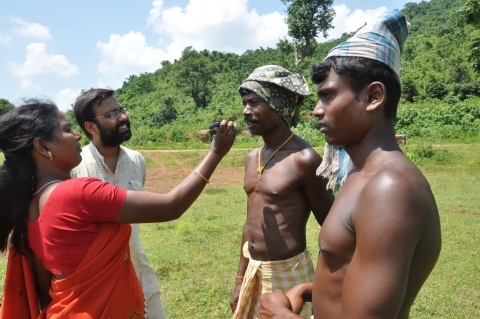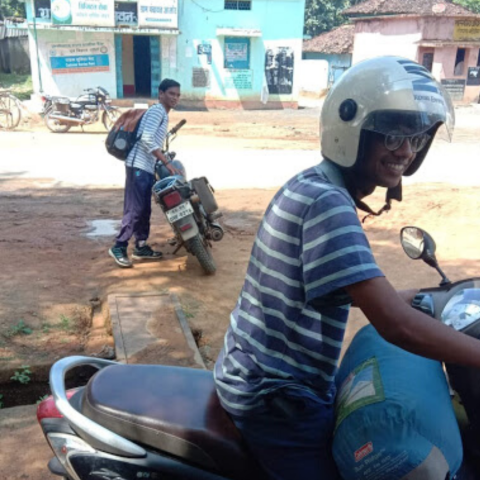Devansh Mehta is the Director of Research Activities at CGnet Swara. Former ICFJ Knight Fellow Shubhranshu Choudhary started CGnet Swara and currently serves as its president.

In today’s media ecosystem, the technology industry sets the rules of the games, with journalism outlets constantly playing catch-up. There is a collective failure of imagination in the media industry to reimagine the future on our own terms, and then go about creating that future.
At CGnet Swara, a citizen journalism platform based in the forests of central India, the future we imagine is one in which every person in society — even those with the fewest resources — can access information and have a voice to make themselves heard. Working out of the Maoist regions in the Dandakaraniya forest, where a civil war has been raging for over 40 years, CGnet Swara works with local tribal groups in these areas (numbering approximately 80 million people by some estimates). Many people in these tribes are unable to read or write, live in areas without internet or cell phone signal and speak only their native mother tongue.
We asked ourselves, “how can we expand citizen journalism and deliver news to this person?”
A study of these areas revealed that even though there may be no signal, mobile phones were found in every village. Even in the more interior zones, villages collectively owned at least one to two cellphones, which were used by either migrant laborers or by people who would travel to the weekly market where signal and internet facilities are available. The villagers used Bluetooth, which doesn’t require internet or signal, to share music and other entertainment files with one another back in their village (a phenomenon also noticed in the Taliban-held areas of Afghanistan). If people in these media dark zones were sharing music with each other through Bluetooth, why couldn’t they also share stories?
Intervention
Although we had a basic idea, we needed to work out the details to make our project work. The hardest part was designing an Android application with proper incentives. We envisioned a villager serving a function similar to that of a “newspaper boy,” going from house to house and using Bluetooth to distribute our audio program through the app.
However, Bluetooth drains the phone’s battery, which is not ideal for villages that may not even have electricity. We needed to design a proper incentive structure that would compensate the “newspaper boy,” or messenger, for their time, the drain on their phone’s battery life and the space taken up on their phone with our audio stories.
Many users in these media dark zones do not have bank accounts or regular access to a bank, making traditional, financial incentives a bust. However, they did all have a phone number that they recharged every month. The final design consisted of providing the messenger with seven cents for every story that they shared through our app via Bluetooth, which could be redeemed when he or she had enough money to reload their phone.
We also wanted the villagers to generate their own stories. To enable these users to report stories from their village, they could also use the app to record audio stories in their mother tongue. Then, when they connect to the internet — whether it be one week or one month — the stories they recorded were sent to our team of moderators, who fact-check, edit and compile these stories into audio programs.

In early September I set out on a 3,500 kilometer road trip through the heartlands of Chhattisgarh to begin testing the app in various villages. I was joined by a local that spoke the language and had been part of our organization since 2014. Ironing out the bugs in the app took more than a month of testing, and we launched the final design in early October.
Results
After finalizing the design, we spent the next five days delivering the app to villagers and training the people that would become our messengers and reporters. The app could not be downloaded, and had to be passed from another existing user.
After the initial push, we passed the program to a training team in our organization that uses a bus to travel from village to village to spread awareness about the citizen journalism platform.
The final results took us by surprise. In the first month it was deployed, our stories were transferred a total of 20,955 times via Bluetooth to 2,443 unique phones. We paid 680 messengers US$930 to reload their cell phones for distributing our stories.
The app also enabled more citizen journalism. Roughly 10% of the users reported at least one story. From Oct. 4-Dec. 24, a total of 528 stories were reported through the app, of which 156 were fact-checked and published on our website, broadcast through social media and distributed back to the community through the app. These stories range from cultural folk songs to longstanding community problems such as not having a road to their village.
Having proven that a radically new means of distributing and collecting content in media dark zones is possible, we discontinued the initiative as our budget for mobile reloads ran out. In the future, our aim is to make this a self-sustaining network through advertisements, and by using this network to buy and sell local goods from villages to cities.
I discussed this experiment with a group of students in the social journalism program at the City University of New York. They asked whether I consider what we did as journalism. From the traditional lens, viewing a journalist as a content creator, it’s probably not. However, the students disagreed, as they believe that journalism delivers information to communities using any and every tool at our disposal.
The old models of journalism are dying, and we have to reimagine our profession in order to create the future, and not just react to it.
This project was funded by the Independent and Public-Spirited Media Foundation, Tata Trusts, Microsoft Research India, South Eastern Coalfields Limited and Internews.
This article first appeared on IJNet here.